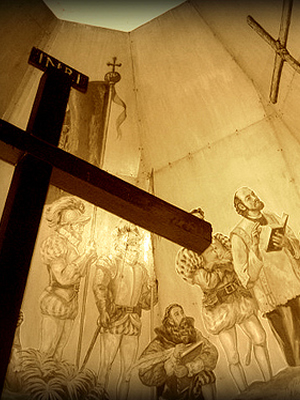Before the Spanish conquistadores came, a thriving community flourished on the banks of the Pasig River. It was called "Maynilad", after the nilad plant whose star-shaped flowers clustered in abundance along the low-lying river banks.
The lord of the riverside kingdom was Raha Sulayman who held court on the south side of the river while his uncle, Lakandula, ruled on the north side. The Spaniards were set on conquering this community. After the savage Battle of Bangkusay, where they overtook the natives with their awesome firepower, the Spaniards conquered Manila. In this Battle, Sulayman was killed.  Realizing its strategic position as a trading center and military outpost, Miguel Lopez de Legaspi, head of the Spanish expedition, promptly declared Manila the capital of the new colonies won by Spain. On June 24, 1571, Manila was declared the capital of the entire achipelago. Delighted by this conquest, the King of Spain awarded the city a coat of arms and the grandiose title: "The Noble and Ever Loyal City". Soon, Manila became a replica of a European medieval city. There were churches, palaces and city halls built in the Spanish baroque style. Work began on building a wall around the city to keep the pirates and Moros at bay. It took 150 years to finish this wall. The end result was an astounding eight foot-thick, three mile-long wall, with two forts and a bastion, 370 guns in place, manned by a force of 5,000 men and 10,000 reserves. This walled city became known as Intramuros.
Realizing its strategic position as a trading center and military outpost, Miguel Lopez de Legaspi, head of the Spanish expedition, promptly declared Manila the capital of the new colonies won by Spain. On June 24, 1571, Manila was declared the capital of the entire achipelago. Delighted by this conquest, the King of Spain awarded the city a coat of arms and the grandiose title: "The Noble and Ever Loyal City". Soon, Manila became a replica of a European medieval city. There were churches, palaces and city halls built in the Spanish baroque style. Work began on building a wall around the city to keep the pirates and Moros at bay. It took 150 years to finish this wall. The end result was an astounding eight foot-thick, three mile-long wall, with two forts and a bastion, 370 guns in place, manned by a force of 5,000 men and 10,000 reserves. This walled city became known as Intramuros.
Beautiful as it was, Intramuros stood as a perfect illustration of the discrimination at that time against the natives called Indios. Although it was built by Indio workers and Chinese artisans, Intramuros was meant only for the clergy and the Spanish nobility. The natives could not enter except to work as servants. Outside the walls, in the arabales or suburbs, lived the Indios, the Chinese and other foreigners. The diversity of trade and culture in the suburbs made it alive and interesting. Tondo, Binondo, Sta. Cruz, and Quiapo bustled with commerce. These places were home to the merchants, carpenters, blacksmiths, carriage makers, masons, and other artisans.
Over the centuries, the Spanish rule was occasionally threatened by attacks from the sea and by internal uprisings. The Chinese, Dutch and British all tried to lay siege on Manila but were unsuccessful. But the 1880's saw the birth of a reform movement led by Marcelo H. Del Pilar, Lopez Jaena and Jose Rizal (the national hero). This reform movement ultimately led to a revolution and by 1898, the days of the Castilian rule were numbered. The most lasting legacy of the Spanish rule was the Catholic religion which makes the Philippines the only Christian nation in Asia.
But as soon as the Spaniards left, the Americans took over. 1902 was the beginning of the American era, a period characterized by the expansion of public education, advances in health care and the introduction of democratic government. The outbreak of war in the Pacific in 1941 disrupted American rule. Manila was declared an open city and the Americans withdrew their defenses. For three years, Manila was occupied by the Japanese imperial forces. Life at that time was made difficult by strict Japanese military rule. When the American troops entered Manila to liberate it, they had to bomb the city to dislodge the tenacious Japanese. Manila was devastated.
On July 4, 1946, a year after the end of the war, the Philippine flag was hoisted signalling the recognition of Philippine independence.
- Details
- Hits: 5069

